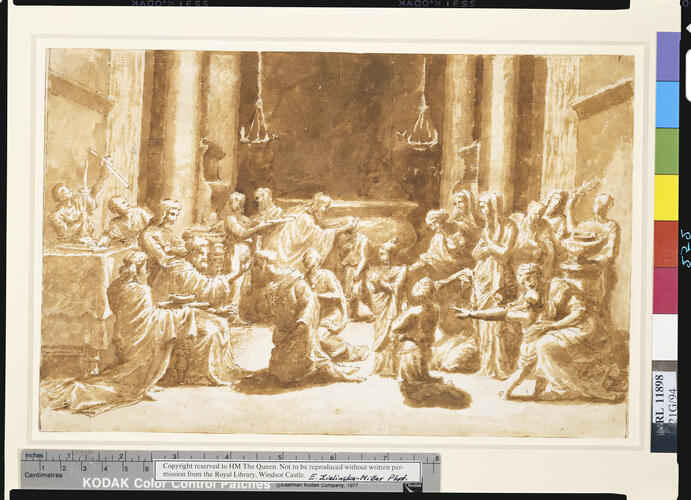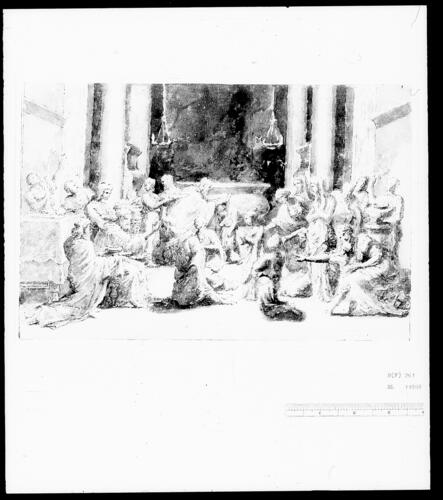-
1 of 253523 objects
The Sacrament of Confirmation c.1645
Pen and brown ink, brown wash, over black chalk; lightly squared in black chalk | 18.6 x 28.7 cm (sheet of paper) | RCIN 911898
-
A study for the painting of Confirmation, from the second set of Sacraments, painted for Paul Fréart de Chantelou and now in the collection of the Duke of Sutherland (on deposit at the National Gallery of Scotland, Edinurgh). We know from Poussin's surviving letters that that painting was begun by 30 April 1645 and finished by 10 December the same year.
This drawing represents the last (and RCIN 911897 the first) stage of development of the composition, and with three intermediate studies in the Louvre (Rosenberg & Prat 1994, nos. 249-51), they show better than any other Sacrament the evolution of the scene and the accumulation of significant detail. The drawing was formerly, and inexplicably, described as a studio work; it is now unanimously accepted as one of Poussin's most brilliant drawings of the 1640s.
The repetition of many motifs in the five known sketches, and the absence of any major pentimenti in the preparatory sketches suggest that Poussin was making use of small models on a stage to work out the composition. The acolyte lighting a candle at the left mirrors the youth with the branch at the right, holding in the composition at either side. A faint horizon line can be seen passing through the heads of the standing figures, and the central vanishing point acts as a focus, not only for the architecture, but also for the inverted V of the confirmands. The light source of two antique hanging lamps is also centralised, and the pools of shadow around the statically posed figures give an atmosphere of deeply felt seriousness - though this dramatic device, highly effective in the painting of Eucharist, had to be abandoned for Confirmation where it would have obscured the face of the main confirmand.
As well as developing the composition in the preparatory studies, Poussin also gradually introduced arcane references to the rites of the early Christian Church. The Renaissance church setting of the first version gives way to a dark chamber, which from the pair of sarcophagi partly hidden by columns in the background is no doubt intended to be a catacomb. The date of the ceremony, Easter Eve, is indicated by the lighting of a Paschal candle on the left, while on the right a youth sprinkles the celebrants with hyssop. The huge bowl in the centre background alludes to the baptism which often took place on the same day as confirmation in the early Church, its size suggesting total immersion of those baptised, and the varied ages of the confirmands emphasizes the routine baptism and confirmation of adults.Provenance
Cardinal Camillo Massimi (1620-1677); from whose heirs bought in 1739, for 300 scudi, by Richard Mead (1673-1754); probably presented to Frederick, Prince of Wales, by 1750.
-
Creator(s)
Acquirer(s)
-
Medium and techniques
Pen and brown ink, brown wash, over black chalk; lightly squared in black chalk
Measurements
18.6 x 28.7 cm (sheet of paper)
Other number(s)
RL 11898Alternative title(s)
La Cresima


